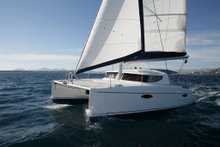It was a lovely sail down the island, it has mostly been cloudy in Palmeira, we suspect in the way that the north of the islands in this area tend to attract the cloud. However, there was only high light cloud in blue skies on the way down and a light swell making for a lovely couple of hours of sailing down the coast.


Coast of Isla da Sal
As soon as we passed south of the airport we saw signs of the development on Sal. The large white sand beach on the south west of the island, Baía da Mordeira, had a large development of red roofed white villas. As soon as we passed the westerly point of the island we could see a number of cranes towering above Santa Maria in the distance. The anchoring in Santa Maria is round a large sandy spit (which extends a mile or two south of the light at Ponta do Sino if arriving at night), the sand is a beautiful light/white and the azore water over them is like something from a picture postcard. The beach extends two or three miles along the south of the island. The area back from the beach is quite heavily developed compared to the rest of the island spreading along the length of the beach, but does not extend far back. However, the appearance from our anchorage is that the developments are sympathetic and low rise with plenty of palm trees etc to landscape the buildings. One of the developments on the far west side of Santa Maria was in a Moorish style and although not completed yet looks very attractive.

Customs House
After our struggles with the anchor in Palmeira (Kevin has already persuaded me we should upgrade to a Rocnor in the Caribbean), we laid two anchors in series here as we are planning to stay a little longer with the assistance of the diving gear and a large fender to float out the second. Kevin reported the water to be warm and very clear with a few flat fish even in the busy local anchorage where we are moored. Now much more confident in the hold, after swabbing the decks to hopefully finally be rid of the persistent red dust we headed ashore by tender. There were a number of people fishing off the pier both local and tourist and we could see hundreds of small bait fish beneath us as we went to tie up. We had contemplated pulling the tender up the beach as we saw a local from another boat doing, however he then removed his outboard and not wishing to carry ours around all night we opted to tie up to the pier as per the pilot guide.
As soon as I picked the painter (rope from front of dingy) we were directed by some locals to use a stainless steel rail on the pier. They took the line and tied us up, then came the inevitable…I’ll look after your boat, not safe to leave here, they pinch your engine etc. We agreed that we’d be gone for two hours and that Van Damm would mind our tender, perhaps naively we did not agree up front on a fee. We walked round the old customs house which had been recently renovated and connects the pier to the town. Within literally two minutes of walking we were joined by another local, whose rejoiner was to comment on my behind, perhaps not expecting me to understand the Portuguese. He was however a nice enough lad called Samba who proceeded to show us round the town, his English was pretty good and offered us a little advice on the cheapest supermarkets, cigarettes, beers etc. He joined us a drink (Coke for himself) and beer for us at the Café Creole. The town was very busy and there were dozens of tourist shops, most of whom employ a fairly hard sell approach if you even glance in their direction, so we were quite pleased to have a guide to avoid the hassle.

Beach at Santa Maria
There are a lot of tourists in the area, so we are told predominantly German, English and Italian, but also Polish, Norwegian, Spanish etc etc. The town is quite nice, though the traffic is fairly busy comparatively, there are people everywhere wandering around though few it seems stopping for drinks in the bars. Whilst we were in Café Creole, the power to the whole town failed, Samson shrugged and said this is Africa man, no stress, obviously a common occurrence. Later in the Bar Calera we saw an candlelit procession from the church, I’m still not sure if the candles had a religious or practical significance, however, it was good to see an aspect of local life not tainted by tourism as around 20 locals filed past in procession singing.

Candlelit procession during blackout
We wondered around a bit more in the dark, visiting the Hotel D’Agua which was still lit up, obviously they have a generator for such occasions. The hotel is lovely, runs right along the side of the beach with wooden walkways and subtle lighting. Though again, there were only about 4 or 5 diners in a restaurant of about 80 covers.
We returned to the tender to find that Van Damm wanted to charge us 2000 Escudos for less than two hours of work, which would compare favourably to the UK minimum wage. We eventually agreed 500 Escudos, which we learned this morning from Max, our Austrian neighbour who spends 6 months a year in the Cape Verdes on his older catamaran that is the going rate. Annoyed but not surprised by this reception to Santa Maria we have decided to do shuttle runs individually during the day, as even this rate is the same as we paid for two rounds of three drinks ashore.

No comments:
Post a Comment